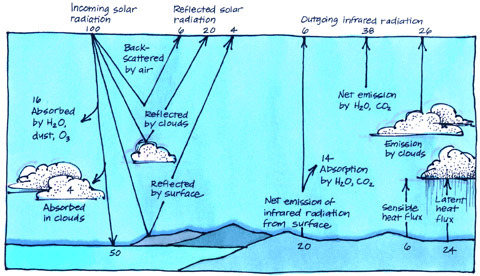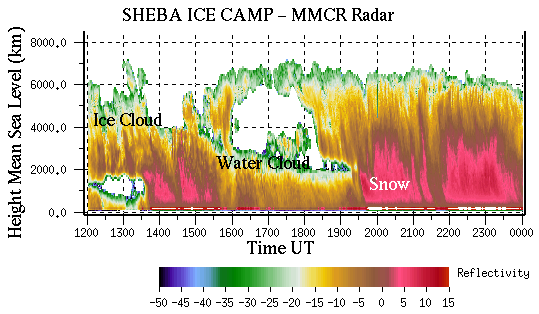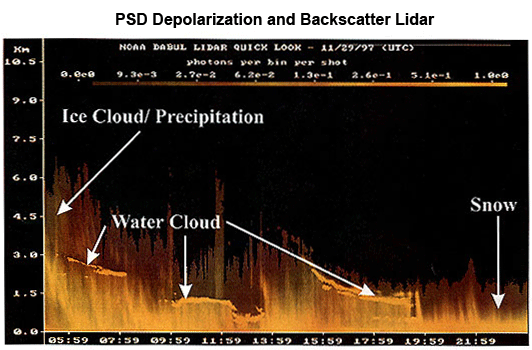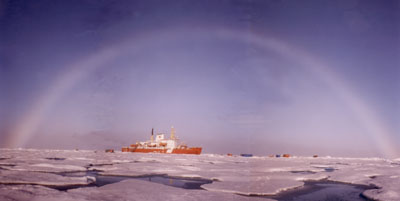Clouds and Climate
Clouds play a vital role in our climate by regulating the amount of solar energy that reaches the surface and the amount of the Earth's energy that is radiated back into space. The more energy that is trapped by the planet, the warmer our climate will grow. If less energy is collected, the climate will become cooler. Understanding this energy balance is fundamental to answering any of the questions posed by climate change.
The Earth's atmosphere has seen large variations in it's history, but only recently have climatologists been finding signs that human activity on the planet is causing climate change. To forecast the impact and severity of these changes, climatologists run computer simulations based on our understanding of the physical dynamics of the environment. These models must include all aspects of the atmosphere, surface and oceans which effect this balance in order to improve the accuracy of their predictions. Clouds are not well represented in these models due to a limited understanding of their energy characteristics (how well they absorb or reflect energy) and distribution (where and how many clouds there are).
What questions do climate researchers ask about clouds?
- How many layers of clouds are there?
- Are the clouds made of ice or water?
- At what altitude is the cloud base? Cloud top?
- How much does it rain? Snow?
- How large are the water dropplets or ice crystals in the cloud?
- What fraction of the sky is cloudy?

Figure 1: Energy can be absorbed, reflected or transmitted by clouds.
|

Figure 2: Radar image showing different phases of water in the arctic atmosphere: Ice clouds, water clouds and snow.
|

Figure 3: Lidar image showing the mixed phase of arctic clouds, containing both water and ice
|
Cloud Characteristics
Depending on their altitude, structure and composition (ice or water) clouds will regulate energy differently. One cloud may trap heat by reflecting energy back to the surface. Another may reflect sunlight and cause the surface to cool. You may have noticed that a cloudless night can be much colder than a cloudy night. Without the heating of the sun and a layer of clouds to insulate us, the surface radiates more heat into space on cloudless nights, making them colder.
To study these characteristics, researchers combine data from a variety of instruments to form a complete understanding of cloud radiative properties. Instruments used to study clouds include:
MilliMeter Cloud Radar (MMCR) developed at PSL uses electromagnetic waves to determine the characteristics of cloud particles from radar reflectivity which is the strength of the signal reflected from the cloud particles. The MMCR can also measure particle velocity, which is determined from the Doppler shift that the particle motion adds to the returned signal. The MMCR was specially designed to detect non-precipitating and weakly precipitating clouds, which have a major impact on climate. This makes it very different from the longer wavelength, weather radars you might see on television which are designed to detect rain, snow and hail.
Depolarization And Backscatter Unattended Lidar (DABUL) developed at PSL uses a laser to measure very weak clouds as well as aerosol particles. DABUL can also distinguish the phase of a cloud, in other words, whether the clouds is made of water dropplets or ice crystals.
Figure 2 and 3 are data taken in the Arctic demonstrates how complex clouds can be with multiple layers of ice and water regions. To distinguish between an ice cloud and a water cloud, scientists combine data from the MMCR and DABUL to determine the cloud boundaries, phase and particle distribution. The DABUL's laser becomes completely absorbed by the water in the clouds, which appear as bright orange bars.
How many clouds are there?
The distribution of clouds also plays an important role in regulating our climate. By knowing how much of the Earth is covered with clouds, climatologists can improve their models and watch for signs of climate change. Increases or decreases in the number and type of clouds could indicate that climate feedback loops are at work cooling or warming the planet.
Counting clouds however is not easily done. From space, satllites are limited to seeing the tops of clouds and many clouds are smaller than the satllite footprint. (A footprint is the horizontal dimentions of a satllite measurement, which can be tens of kilometers along a side.)
From the surface, cloud observations have traditionally been made by a human observer, which are often very inacurate, especially at night. Radars and lidars are much more accurate. However, because the technology is new and expensive there are only a handful of these instruments operating. Surface observations will always be limited in harsh, sparsely inhabited environments. This problem is being addressed by speciallized field programs which study clouds in these environments.
Clouds in the Arctic

Fine ice crystals in the cold, dry air of the Arctic refract light into an icebow.
|
One such program, the Surface Heat Budget of the Arctic Ocean (SHEBA), at the University of Washington was designed to address the scarcity of climate data in the Arctic. The Arctic is a critical climate zone due the extremes of solar energy it receives and the effects it can have on the surrounding oceans. During SHEBA, researchers spent a year on the ice of the Arctic Ocean, measuring the energy exchanges between the ocean, the ice and the atmosphere. A critical component of the atmospheric measurements were the cloud observations made with the MMCR and DABUL.

Cumulus in the tropical western Pacific.
|
Clouds in the Tropics
In another sparsely inhabited climate zone, the Tropical Western Pacific (TWP), the PSL MMCR and DABUL will make identical measurements of tropical clouds. Deployed on the deck of the NOAA Ronald H. Brown, clouds measurements will be taken as part of the JASMINE and Nauru99 programs The TWP is considered the "furnace" of the planet, absorbing solar energy and converting it into atmospheric water vapor (clouds). Climate change in the TWP impacts world wide weather as has been dramatically demonstrated by El Niño.